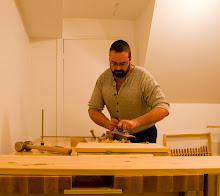This post is not about hitting things with hammers. This post is about using a paring chisel, and it's a process that can be peaceful or poisonous depending on how well you sharpen your chisel.
Firstly, let's meet my favourite paring chisel.
Normally, a paring chisel has a very long blade to allow more control, a
 nd to help to get into places that are far from an edge. My favourite paring chisel is no different, but because it is so wide, and the handle is so long, it looks perfectly in proportion.
nd to help to get into places that are far from an edge. My favourite paring chisel is no different, but because it is so wide, and the handle is so long, it looks perfectly in proportion.Shown are two chisels. The paring chisel, below, doesn't look particularly unusual until you realize that the chisel above is a 1" Hirsch firmer chisel. That would normally be considered a pretty beefy bench chisel. The 1-1/2" Sorby paring chisel dwarfs the Hirsch considerably. The blade on the paring chisel is quite thin, and the bevel is long, with an angle of around 20 degrees.
The chisel is so big, with so much surface for registration against the work, that it is easy to take the cut that you want. It's lovely.
It is paramount that you keep a paring chisel very sharp. Very, very sharp. I'm going to get into sharpening in another posting very soon.
Here is a shot of paring to a straight line. I intentionally stopped
 short on the hacking cuts because I wanted to leave the 'shavings' (chunks, really) in place so you could see them. Paring need not be delicate. Normally I wouldn't pare right to a line, I'd leave a bit for finishing with a plane or spokeshave. You can't take too thick a section of wood at once or it will split out. If you begin hacking at the far end then what you're paring off is flexible enough that it won't interfere and works just dandy. This was all done just by pushing the chisel. No mallet.
short on the hacking cuts because I wanted to leave the 'shavings' (chunks, really) in place so you could see them. Paring need not be delicate. Normally I wouldn't pare right to a line, I'd leave a bit for finishing with a plane or spokeshave. You can't take too thick a section of wood at once or it will split out. If you begin hacking at the far end then what you're paring off is flexible enough that it won't interfere and works just dandy. This was all done just by pushing the chisel. No mallet.
Another shot, this time of paring to a curved line. Same process.

Something that a paring chisel is particularly good at is cleaning up end-grain. If you just push the chisel then you get the same kind of cut that a plane would take, which isn't always optimal. The cut to the right was taken with a straight push, and the shaving is sitting there. The cut is pretty good, but it's a bit 'cheesy' as the old books say. It has the slight voids and general visual texture of sliced, aged cheddar. It looks okay, but it feels a bit rough.
However, there is a cut that the old books call a 'compass cut' which works wonders
 on end grain. In this cut you select a point on the chisel, usually about as far back from the tip as the blade is wide, and this will be your axis or swivelling point. You press your thumb hard on this point of the bevel-up blade, and swing the handle back and forth while pushing forward and the net effect is that you get a slicing cut. It's not as fast as a straight push, but it leaves a finish as smooth as glass. You can see in the shot to the left that the left-hand side of the surface, the part done with the compass cut, doesn't reflect light from ragged end-grain the way the right hand side does. It doesn't look hugely different, but it sure feels different. Oh, and I didn't even sharpen the chisel before paring that end-grain. I haven't sharpened this particular chisel since the last time I used it a couple of weeks ago. More on sharpening later.
on end grain. In this cut you select a point on the chisel, usually about as far back from the tip as the blade is wide, and this will be your axis or swivelling point. You press your thumb hard on this point of the bevel-up blade, and swing the handle back and forth while pushing forward and the net effect is that you get a slicing cut. It's not as fast as a straight push, but it leaves a finish as smooth as glass. You can see in the shot to the left that the left-hand side of the surface, the part done with the compass cut, doesn't reflect light from ragged end-grain the way the right hand side does. It doesn't look hugely different, but it sure feels different. Oh, and I didn't even sharpen the chisel before paring that end-grain. I haven't sharpened this particular chisel since the last time I used it a couple of weeks ago. More on sharpening later.
No comments:
Post a Comment